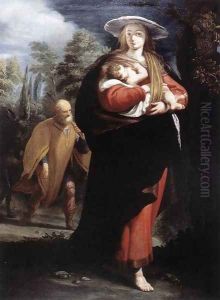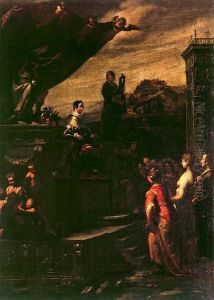G. Andrea Ansaldo Paintings
Giovanni Andrea Ansaldo, often known simply as Andrea Ansaldo, was an Italian painter active during the early Baroque period. Born in 1584 in Voltri, now part of Genoa, Ansaldo was a prominent artist of the Genoese School, which flourished in the late 16th and early 17th centuries. Ansaldo's work is characterized by its vibrant colors, dynamic compositions, and a certain gracefulness in the depiction of figures, which often reflects the influence of the great Flemish painter Peter Paul Rubens, who spent time in Genoa.
Ansaldo initially trained under Orazio Cambiaso, the son of the famed Luca Cambiaso, who was a leading figure in Genoese painting. Ansaldo's early works show the influence of his teacher and other contemporaries, but he soon developed his own distinct style that combined local traditions with elements absorbed from other Italian and foreign artists.
Throughout his career, Ansaldo worked on a variety of projects including altarpieces, frescoes, and private commissions. One of his most significant works is the fresco decoration of the dome of the Basilica della Santissima Annunziata del Vastato in Genoa, which is considered a masterpiece of Ligurian Baroque art. His other important works include 'The Virgin with Saints' for the church of San Bartolomeo degli Armeni, and 'The Miracle of St. Diego of Alcalá', which reflects his ability to convey narrative effectively.
Ansaldo was also a teacher, and his studio was influential in the training of the next generation of Genoese artists. His contributions to the development of the Genoese School were significant, and his work helped to establish Genoa as an important center of art during the Baroque period. Andrea Ansaldo died in 1638 in Genoa, leaving behind a lasting legacy as one of the city's most important artists.

